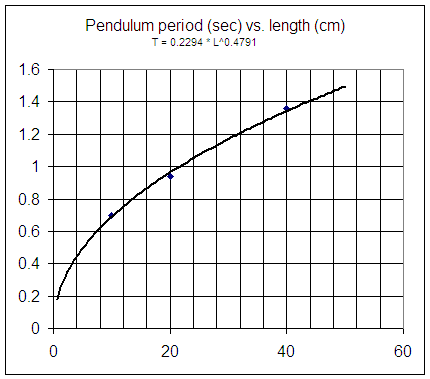class 050824
Based on the observations made in one class, here is a graph of pendulum
period vs. length. The function that according to this graph relates
period and length is T = .23 L^.48, approximately, where T is period in seconds
and L is length in cm.

According to this graph:
- What is the period of a pendulum of length 30 cm?
- What pendulum length would give us a period of 1 second?
- By how much would the period of the pendulum change between lengths of 10
cm and 20 cm? How much between 20 cm and 50 cm?
- Does the period of the pendulum change more per additional cm of length
between the 10 cm and 20 cm lengths, or between the 20 cm and 50 cm lengths?
According to the function T = .23 L^.48:
- What is the period of a pendulum of length 30 cm?
- What pendulum length would give us a period of 1 second?
- By how much would the period of the pendulum change between lengths of 10
cm and 20 cm? How much between 20 cm and 50 cm?
- Does the period of the pendulum change more per additional cm of length
between the 10 cm and 20 cm lengths, or between the 20 cm and 50 cm lengths?
The observed periods for lengths of 15 cm and 40 cm are approximately .7
seconds and 1.35 seconds. If it is known that the period is related to the
length by a function of the form T = A * L^p, then
- What do you get when you plug the length and period of the 15 cm pendulum
into this equation?
- What do you get when you plug the length and period of the 40 cm pendulum
into this equation?

